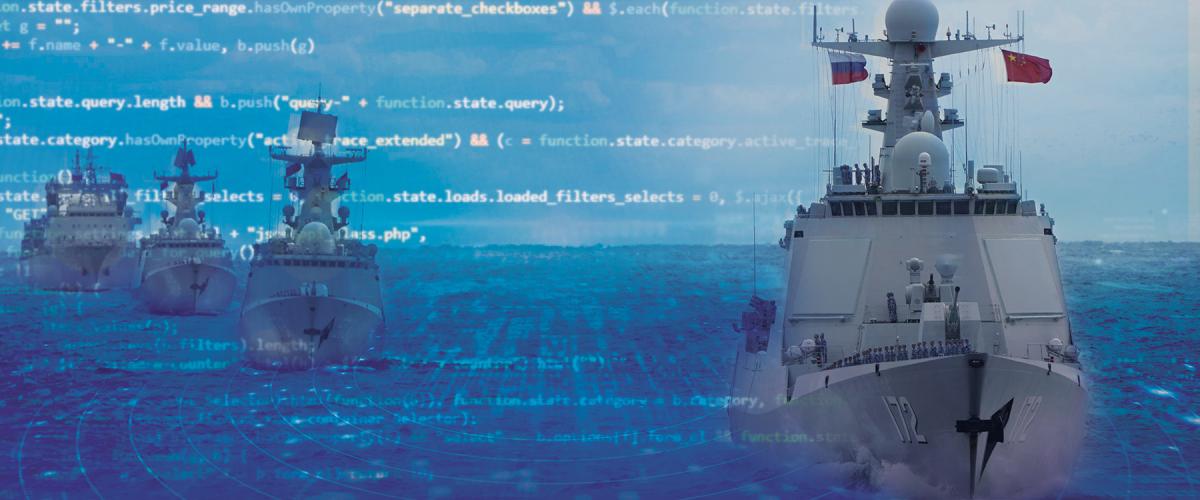China has embarked on a program to replace the liberal world order with a techno-authoritarian model dominated from Beijing. Central to this program is a desire to control the maritime commons. China is now a (in some measures perhaps the) leading sea power. It boasts the world’s largest navy, coast guard, and maritime paramilitary forces; a top-five merchant fleet; significant shipbuilding capacity; and growing control over a global network of maritime ports.
Meanwhile, decades of questionable acquisition decisions, strategic blunders, and debilitating intellectual frameworks on maritime and cyber power have eroded U.S. advantages and access to the sea and electromagnetic spectrum. The United States is well within the envelope of strategic surprise, and time is not on our side.
The Challenge from China
Much attention is focused on China’s massive investment in its navy without an appreciation of how cyber-enabled warfare contributes to China’s sea power. Navalists think about cyber power and sea power in the same limited way. They argue over fleet size while neglecting the industrial base and logistics. Similarly, they focus on “hacking” without considering training and talent, cyber infrastructure, capabilities, operational concepts, or nesting into larger campaign plans or strategies. They want to “hack” ships or air defense instead of the ports, shipyards, logistics, and populations that win wars.
In contrast, China’s long-term cyber-enabled strategy aims to capture and control key strategic industries and resources to realize its maritime aspirations.1 This includes dominance in semiconductors, undersea networks, and shipbuilding. China uses cyber power to enhance its power-projection capabilities and alter the global balance of power such that U.S. defense officials now concede that China is the “pacing” challenge, likely surpassing some (most?) U.S.
naval capabilities.
The U.S. response has been slow. Only in 2018 did the Department of Defense shed its “doctrine of restraint” in cyberspace and adopt the active operational approach of persistent engagement in support of a strategy of defending forward.2 This break from legacy thinking—which assumed deterrence alone created security in the information space—has yet to be internalized across the national security enterprise. Defense planning remains mired in configuring forces to deter or prevail in war, while adversaries employ computing technology and algorithmic decision-making to achieve strategic effects outside armed conflict.
Even U.S. cyber forces remain wedded to legacy operational approaches and targeting cycles. Cyber planning today is underpinned by “critical node analysis,” which assumes that discreetly delivering effects on system links and nodes will generate effects that disrupt or defeat adversary operations. This limits cyberspace operations to a nonkinetic means to deliver physical effects. Joint doctrine still refers to “cyber fires,” shoehorning operations into 20th-century targeting cycles and creating the fantasy that, through cyberspace, targets can be held “at risk” and “actioned at a time and place of our choosing.”3 This misunderstands the nature of cyberspace—its resiliency, redundancy, fleeting accesses, and ever-changing terrain—and the nature of cyber power.
Information is a strategic resource, like fuels or food, required to pursue military, diplomatic, economic, and political goals. Cyber power, therefore, is central to state functions, military operations, and power projection. Modern conflict and competition require networks and network operations to achieve desired effects. U.S. defense and military officials, however, still see cyber operations as an extension of conventional warfighting capabilities.4
Early Intellectual Constraints
The early uses of cyberspace capabilities were highly selective and secretive, with employment decisions held at the highest levels of government—much like nuclear weapons employment. The fact that intelligence services were the first to exploit cyberspace for interstate competition, principally as a means of espionage, kept cyber operations compartmented from traditional military planning and warfighting. These two constraints—cyber = nuclear and cyber = compartmented—left cyberspace capabilities occupying the narrow space reserved for strategic nuclear deterrence and sensitive intelligence collection. This was institutionalized in 2010 by placing the newly established U.S. Cyber Command under U.S. Strategic Command (where nuclear forces are controlled). Collocating it with the National Security Agency (where sensitive signals intelligence is conducted) and dual-hatting its commander as director of that agency reinforced intelligence equities over operations. While these decisions had some merit, the unintended effect was to constrain efforts to use information to increase sea power. Cyber power and cyberspace operations remained an afterthought to sea power.5
Sea Power and Cyber Power
Sea power and cyber power share many characteristics. They depend on commercial industries, infrastructure, and technological innovation. They operate globally. Both are shaped by political organization, culture, human capital, economic arrangements, defense considerations, foreign partnerships, and global norms. Growing and maintaining sea power and cyber power requires serious commitment on the part of the state.
Both are interdependent and rely on access to the electromagnetic spectrum. Sea power uses cyberspace for navigation, communication, commercial functions, military command and control, and maritime domain awareness. Current U.S. maritime strategy relies on distributed operations, which can be accomplished only through network operations and spectrum access to coordinate manned and unmanned systems across thousands of miles in all domains.6 Principal supporting functions—from ship design and construction to port operations, supporting infrastructure, and industrial control systems—require robust and resilient networks. Cyber power and cyberspace operations depend on global telecommunication networks built on a physical infrastructure of undersea cables and landing stations. More than 90 percent of all international data traffic in cyberspace traverses undersea networks.7 Each can enable the other: Cyberspace operations can enable the projection of sea power, and maritime platforms can be the launch point of cyberspace operations to achieve effects. They can serve as different reinforcing means to achieve similar ends. This is a conceptual approach familiar to sea power strategists.
Yet, there are distinctions. The barrier to entry for sea power is high; ships are expensive to build, operate, arm, man, and maintain. Small states, however, can exercise global cyber power far above their relative shares of economic power. The number of actors in cyberspace is large and increasing. The speed and scale of cyberspace operations exceed those of maritime operations and can be sustained indefinitely. Fundamentally, sea power is subject to attrition, while cyber power is not.
Yesterday, Today, and Tomorrow
There are historical examples of how new domains interact with old domains. In the 16th century, states took advantage of improved ship design and celestial navigation to bypass overland trade routes controlled by Imperial China and the Ottoman Empire. Through the control of critical waterways and ports, Portugal was able to dominate the Indian Ocean from thousands of miles away. Improved navigation and seagoing capabilities provided maritime states enduring advantages over land powers.8
In the early 20th century, air power fundamentally changed the character of sea power. The range at which targets could be spotted and the means by which they could be struck vastly increased, and by World War II, the number of enemy ships sunk by airplanes and torpedoes far surpassed the number that succumbed to naval gun action. This led to wholesale changes in fleet tactics, strategy, and force composition, generating consequent demands on training, logistics, and human capital.
Today, the maritime domain is being touched by the cyber domain, with profound implications. China has employed cyber-enabled means to shift the balance of global sea power. Its broader neomercantilist campaign, spanning more than 60 countries, two-thirds of the world’s population, links land, sea, financial, and digital corridors back to China. This includes owning and operating more than 100 ports in 63 countries, including key allied ports.9 China’s influence over maritime links and nodes depends on dominance over global telecommunications.
These developments have put China on a path to deny U.S. naval freedom of navigation and maneuver. Any U.S. warship or support vessel that puts into a port under influence of China is at risk of cyber surveillance, penetration, or even sabotage. Potentially, ports can be denied to U.S. warships at the request of China, using its financial leverage or port infrastructure control. More worrisome is China’s dominance over the manufacture and operation of maritime port cranes that are essential to operations in the United States and globally, extending digital surveillance into U.S. harbors.10 American sea power is now subject to constant observation.11
Chinese cyber forces have penetrated and exfiltrated terabytes of intellectual property on major naval programs, platforms, and capabilities from U.S. defense contractors. Beyond stealing technology, China has converted and quickly fielded its own versions of stolen systems and platforms, leaping ahead and saving billions of dollars in research and development.12 Little headway has been made in preventing technology theft and conversion, and the government, military, and contractors continue using high-risk vendors.13 No amount of “cybersecurity awareness training” can compensate for the use of compromised technology in sensitive networks or the failure to contest Chinese intellectual property theft through network exploitation.14
In the undersea domain, Chinese deployment of cyber-enabled capabilities, such as acoustic wave communication technologies and modems, may negate the U.S. Navy’s primary means of projecting sea power and deterrence. Undersea stealth and sanctuary are in jeopardy. Through distributed remote-sensing networks connected to autonomous vehicles and communicating via underwater wireless means, China can persistently observe the undersea environment and employ undersea platforms and weapons. China’s “Blue Ocean Information Network” includes sensors, high-frequency radio, cellular masts, and radar domes spread throughout the South China Sea and Pacific. This network is likely connected to China’s “Underwater Great Wall,” a series of seabed network arrays designed to detect and track submarines.15
Similarly, satellite technology is critical to maritime intelligence, surveillance, and reconnaissance (ISR) systems. Technologies such as big data analytics and artificial intelligence enhance the capabilities of adversaries to find, track, and target U.S. naval platforms from space. The United States also is investing in maritime ISR; however, China’s growing leverage over commercial space companies, supporting information technology components and hardware, and strategic resources position it to control supply chains for space systems. This could disrupt U.S. military access to space and threaten the ability to conduct maritime domain awareness and distributed operations.16
Other novel cyber approaches can affect sea power. China is investing heavily in cyber-enabled cognitive manipulation to shape population behavior.17 Attention-based economic models use neuroscience to generate addictive properties in social media platforms, such as Chinese-controlled TikTok.18 Especially popular with young sailors, TikTok captures biometric, personally identifiable, and geolocational data on users and makes it available to Chinese authorities. It is also a useful means to push narratives that influence behaviors and attitudes. This opens the door to a variety of influence, exploitation, and subversion operations on military and civilian personnel integral to American sea power.19
China also uses open-source intelligence to track U.S. and allied maritime units and personnel. Pervasive use of Chinese-controlled social media and information technology threatens operational security. For example, users of Twitter and Facebook can view real-time battle damage assessments, track troop movements and deployments, monitor political announcements, and observe combat operations as they occur in near-real time in the Russia-Ukraine war.20 The ubiquity of sensors, especially people with “smart devices” equipped with cameras, makes this possible. Early analysis suggests that Ukraine is enjoying some success influencing narratives within Western media, affecting and driving political decisions. Conversely, Russian cyber-enabled attack and influence activities probably have not generated the impact hoped for.21 Instead, Russian and Chinese influence operations seem targeted to audiences outside the West, which may explain why they remain ambivalent or even “pro-Russian.”22
What Must Be Done?
New technologies in navigation, sailing, ship construction, and air power, when wedded to new operational doctrine, changed the character of sea power. Today, cyber technologies are having a similar impact. As the examples above show, cyberspace and the information environment have made competition as consequential as conflict. Competition in this space requires shifting the strategic outlook from one of deterrence and coercion to an initiative-persistent framework that hopes to “thwart and frustrate adversaries before they lock in gains.”23
Legacy intellectual frameworks no longer suffice because cyber has a low barrier to entry, is difficult to attribute, and has ambiguous “redlines” and pervasive system vulnerabilities that “invite exploitation for strategic gain” outside the realm of conflict.24
Navalize Cyber
Meaningful fleet-oriented cyber power will require new strategic approaches and capabilities. Navy cyber mission teams today are either limited to rudimentary afloat network defense, supporting combatant command requirements, or directed to be prepared to respond in the event of conflict. Modern fleet-oriented cyber requires much more.
Addressing cyber vulnerabilities in Navy combatants, support vessels, and merchant shipping should be a top concern of all fleet commanders. The Department of the Navy (DoN) also must develop strategies and tactics that take advantage of unique access opportunities—from the seabed to the littorals—provided by maritime platforms. And it must employ those concepts and doctrines continually in competition.
The DoN must align cyber talent acquisition, development, and management to create maritime cyber forces with deep expertise rather than a dated model of sea-shore rotations and permanent change of station move cycles. It must rapidly field cyber capabilities, including radio frequency-enabled ones, onto legacy platforms and networks that can deliver effects on military systems as well as populations. Employment authorities must be held at the deploying group level by information warfare commanders. These capabilities must be practiced and integrated into unit-level training, group exercises, and wargames.
Cyber power can best support American sea power by altering the trajectory of Chinese sea power. This will require persistent campaigns to shape China’s economic growth, attack its sources of sea power, disrupt its civil-military fusion program, and conduct influence campaigns within and outside China. Naval cyber lines of effort might include: 1. rendering Chinese maritime enterprises less desirable and reliable; 2. impeding and misdirecting Chinese maritime technological self-sufficiency; 3. disrupting and degrading China’s maritime industry and logistics; 4. protecting undersea cable networks; and 5. developing and employing cyber-enabled campaigns to disrupt and degrade Chinese merchant fleets, maritime paramilitary forces, and fishing fleets. Such naval campaigns will demand realistic net assessments of Chinese and U.S. sea and cyber power and the ability to forecast strategic latency and disruptions.
Fundamental to these ends will be a strategic approach that shapes China’s course across all elements of power. As U.S. military leaders think of and use sea power as an asymmetric advantage, they must employ cyber power for strategic advantage in the maritime domain.
Most important, senior U.S. decision-makers must agree on the broad contours of strategic competition with China and obtain support from the American people. This demands a sense of urgency and risk tolerance that measures time horizons in months and weeks, not years and decades. We have no time to lose.
The author would like to thank Dr. Emily Goldman and Dr. Michael Warner from U.S. Cyber Command for their review and recommendations on this article.
1. LCDR Robert “Jake” Bebber, USN, “China’s Cyber-Economic Warfare Threatens U.S.,” U.S. Naval Institute Proceedings 143, no. 7 (July 2017).
2. Emily O. Goldman, “Paradigm Change Requires Persistence—A Difficult Lesson to Learn,” The Cyber Defense Review 7, no. 1 (Winter 2022): 113–18.
3. Joint Chiefs of Staff, Joint Publication 3-12: Cyberspace Operations (Washington, DC: Department of Defense, 8 June 2018).
4. Robert “Jake” Bebber, “Cyber Power and Cyber Effectiveness: An Analytic Framework,” Comparative Strategy 36, no. 5 (November 2017): 426–36.
5. This does not mean cyber operations are not conducted on maritime platforms or from shore supporting maritime operations. Operators do conduct network defense, network analysis, forensics, and interactive operations within narrowly limited authorities.
6. Edward Lundquist, “DMO Is Navy’s Operational Approach to Winning the High-End Fight at Sea,” Seapower, 2 February 2021.
7. Francesco Bechis, “Undersea Cables: The Great Data Race Beneath the Oceans,” Italian Institute for International Political Studies (blog), 31 May 2021.
8. Michael Warner and John Childress, The Use of Force for State Power - History and Future (Cham, Switzerland: Palgrave Macmillan, 2020).
9. Matthew Rochat, “China’s Growing Dominance in Maritime Shipping,” The Diplomat, 18 December 2021.
10. WCN Editorial, “FBI Raids ZPMC Delivery Vessel,” World Cargo News, 23 September 2021.
11. China understands this vulnerability and recently directed that all Chinese automatic identification system (AIS) data providers shut down international access while operating in Chinese territorial seas. See: “Report: New Data Law Cuts Off Access to Chinese AIS Tracking,” The Maritime Executive, 17 November 2021.
12. Michael Fischerkeller, “Opportunity Seldom Knocks Twice: Influencing China’s Trajectory via Defend Forward and Persistent Engagement in Cyberspace,” Asia Policy 15, no. 4 (October 2020): 65–89; and Richard J. Harknett and Max Smeets, “Cyber Campaigns and Strategic Outcomes,” Journal of Strategic Studies 45. no. 3 (March 2020), 1–34.
13. Nicole Sganga, “Chinese Hackers Took Trillions in Intellectual Property from About 30 Multinational Companies,” CBS News, 4 May 2022.
14. Sheridan Prasso, “China’s Tech Grip Persists in U.S. Long After Orders to Rip It Out,” Bloomberg News, 11 May 2022.
15. Ewen Levick, “China’s Underwater Great Wall,” Maritime Executive, 18 June 2018.
16. Marc Julienne, “China’s Ambitions in Space: The Sky’s the Limit,” Ifri Studies, January 2021.
17. Elsa Kania, “Minds at War: China’s Pursuit of Military Advantage through Cognitive Science and Biotechnology,” PRISM 8, no. 3 (2020).
18. Attention-based economic models seek to drive consumer behavior by keeping the consumer connected to a platform or service. Examples include social media or video streaming services.
19. Jason Aten, “The Department of Defense Is Warning People Not to Use TikTok Over National Security Concerns,” Inc., 9 January 2020.
20. Peter Aldhous and Christopher Miller, “How Open-Source Intelligence Is Helping Clear the Fog of War in Ukraine,” BuzzFeedNews, 2 March 2022.
21. Elizabeth Gibney, “Where Is Russia’s Cyberwar? Researchers Decipher Its Strategy,” Nature, 17 March 2022.
22. Carl Miller, “Who’s Behind #IStandWithPutin?” The Atlantic, 5 April 2022.
23. Goldman, “Paradigm Change Requires Persistence.
24. Goldman.










